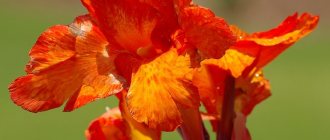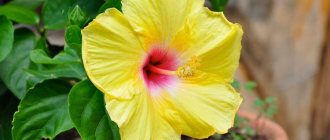Miniature roses are small copies of various garden forms of roses brought to Europe from distant China at the end of the 19th century. On their basis, at the end of the 20th century, many indoor roses of different shades were bred in many countries: from soft white to black. Miniature shrubs 20-40 cm high with leaves 2-3 cm and flowers 1.5-2 cm in diameter are very beautiful and elegant. To grow them, you need a bright, well-ventilated room. In summer, the plant needs to be slightly shaded from the scorching rays of the sun and cared for as usual, like other indoor plants. But caring for indoor roses in winter has its own rules.
Why don't indoor roses bloom in winter?
The long dormant period that indoor roses enter in winter makes caring for them a little more difficult. Many amateur flower growers, not knowing about this feature, rush to throw away the plant, considering it dead. The period of “sleep” for indoor roses begins around the end of November. This is facilitated by a decrease in daylight hours and a decrease in outside air temperature. The plant, which grows actively in summer, gradually stops blooming and slowly sheds its leaves. Having exposed its branches, the domestic rose “falls asleep” in winter until spring. How to properly preserve this delicate plant?
How to care for indoor roses in winter?
Caring for a home rose in winter is not a very labor-intensive process; even a novice amateur gardener can do it:
- First, you need to take the flowerpot with our rose to a cool room, for example, to a glassed-in loggia or balcony.
- It is not recommended to keep a flower in an apartment - it will simply dry out without leaves and die.
- There should be no drafts in the room.
- The air temperature should not fall below +4 degrees Celsius.
- It is not recommended to place the flower near heating radiators, as dry air can kill your plant.
- You should not use a refrigerator for winter storage of home roses; the plant needs fresh air and little lighting.
Caring for indoor roses at temperatures below zero
How to preserve an indoor rose in winter if the temperature on the loggia has dropped to zero degrees or below? The plant can withstand a decrease in temperature, but only for a few days. To protect the rose from frostbite, you need to mulch the soil in the flowerpot (cover with a layer of pine needles or leaves). The flowerpot itself should be insulated by wrapping it with cotton insulation, an old piece of natural blanket or other warm material. You should not cover the rose with a jar, condensation will form under it, and the lack of air exchange will lead to rotting of the plant or the proliferation of pathogenic bacteria. In winter, the plant should not be watered too much, so as not to completely dry out the soil (at least 1-3 times a week, depending on the overall humidity of the room). To stimulate the growth and flowering of the plant, it is necessary to prune indoor roses for the winter. It is more advisable to carry it out immediately after it sheds its leaves. To do this, take a sharp, disinfected knife (so as not to infect the plant with fungal diseases) and cut off the branches, leaving 3-4 buds.
Following our recommendations, winter care of indoor roses and preparation for winter will not create big problems or surprises for you. At the end of February, the indoor rose should be moved to a warmer and sunny place, gradually increasing the light, the humidity of the soil in the flowerpot and the air temperature. After removing the mulching, it is better to disinfect the soil, since dry needles and leaves can be a source of fungal diseases. Flower shops sell a lot of different products for this purpose, directly for indoor roses. And already in March, expect the first spring flowers.
Who can resist the charm of delicate rose buds? Certainly not keen flower growers!
Therefore, every flower lover simply must have a rose in a pot in his home collection.
Very often the purchase of a rose turns out to be spontaneous. Of course, because in the store they look very attractive. Indoor roses are often given to women who love flowers.
In any case, if you purchased a rose or received it as a gift, you will definitely find our article useful.
How to save an indoor rose after purchase
The rose is a difficult flower to keep at home; it is quite demanding and capricious. It is not enough to become the happy owner of this beauty, you also need to preserve the flower and find an approach to it, otherwise sad consequences will not keep you waiting.
Yes exactly. The purchased plant usually looks fresh and full of vigor, blooms amazingly and it seems that it will always be like that.
In fact, the plants arrive on the counter fed with all kinds of stimulants; in addition, they have special packaging that retains high humidity. Once on our windowsill, roses are deprived of all this.
Almost immediately, inexperienced gardeners have problems: the roses begin to turn yellow, their leaves dry out and fly off, the buds fall off and turn black. Rosette orders to live long and disappears, leaving behind nothing but frustration.
It should be noted that the rose is considered an open ground plant. Some varieties are more suitable for indoor use than others. But this does not mean that keeping them in an apartment is an easy matter.
When purchasing an indoor rose, after purchase it is simply necessary to take a set of rescue measures, even if the plant looks healthy and strong. Believe me, it won't last long!
So, what steps should you take when you bring a rose home:
- Remove the packaging wrapper, if any. Although the packaging helps to retain moisture, it often causes the rose to become infected with fungal diseases while still in the store, because... packaging interferes with air exchange, creating an ideal environment for fungi.
- Use pruning shears or scissors to remove all wilted leaves, blackened and dried stems that are on the plant.
- Flowers and buds also need to be trimmed. Of course, for the sake of them we buy a plant and we would like to admire them to our fullest, but the plant, the flowering of which was stimulated by special preparations and greenhouse care, subsequently simply cannot withstand such abundant flowering, and, having given all its strength to it, dies. Therefore, we cut off all the flowers and buds that are present on the plant, along with the supporting stem.
- Pay attention to the number of bushes in the pot. Growers of indoor roses often plant several plants in one pot to create the appearance of a lush flowering bush. Crowded plants weaken each other and there is a lack of nutrients. Bushes, if there are several of them, must be planted in different pots.
- After transplantation, it is necessary to treat the rose with antifungal drugs (Fitosporin) and pest control drugs (Fitoverm).
Possible problems in growing
A home rose in winter, the care of which has its own characteristics, can lose its attractiveness and even get sick. The reason for this is non-compliance with the rules of agricultural technology.
Yellowing of leaves
A healthy plant, preparing for a period of dormancy, begins to shed leaves that initially turned yellow. This is a natural process that can be intimidating for an inexperienced gardener.
If the plant is in the phase of active growth and flowering, the cause of loss of leaf shade may be sunburn, the use of too cold water for irrigation, regular drying out of the soil, drafts and high humidity of the substrate.
A deficiency of nutrients in the soil can also provoke yellowing of the foliage. With a lack of potassium, spots additionally appear on the leaves. Iron deficiency is accompanied by the formation of small veins.
Falling leaves
This process is usually observed when a flower is damaged spider mites . Improper winter care, too dry air and frequent drying out of the soil are the main causes of pest damage.
To restore the attractiveness and maintain the health of the plant, it is recommended to treat it with Actelik , Fitoverm and Fufanon . Prevention of damage will be regular inspection of the bush with special attention to the back side of the leaf.
Homemade rose, how to care for it in winter is described in the article. If everything is done correctly, the plant will thank you for your attention with long and abundant flowering. By observing all the subtleties of agricultural technology, you can maintain the health of the rose even without maintaining the dormant phase.
Transplanting an indoor rose
To replant a rose, remove it from the previous pot along with the earthen lump. Assess the condition of the roots entwined in the ground.
If the roots are hair-thin, brown or blackened, dry or rotten, the plant will most likely die. You can try to save it: cut cuttings and try to root them.
Healthy roots are bright white or yellowish in color and look quite dense, like a thin wire. If the roots are only partially missing, you need to remove all the rotten and damaged ones, leaving the healthy ones.
Place expanded clay or other drainage at the bottom of the new pot.
It is better to purchase a soil mixture ready for roses or a garden mixture. Do not use cheap soil; it contains a lot of peat and few nutrients. It is better to choose a higher quality soil mixture.
You can make your own soil mixture by taking: 1 part humus + 1 part leaf soil + 1 part coniferous soil + 3 parts turf soil + 1 part sand.
Fill the drainage with soil and compact it a little. Place the rose bush together with a lump of earth, cover it with new soil, periodically compacting it so that the bush does not dangle in the pot, but is well fixed. Water with settled or filtered water at room temperature.
Treatment against diseases and pests is necessary. A pruned and replanted plant is weakened and susceptible to disease, even if it was well cared for at the store and no infection occurred. Therefore, it is better to play it safe and process it.
Also, after transplantation, treatment with Epin is effective - it will strengthen the plant’s immunity and reduce stress from transplantation.
Spray your plant; it requires high humidity, especially in conditions of operating heating and dry air in the apartment. If the rose is very small and weak, then the pot can be covered with a bottle (with small holes) on top, creating a greenhouse, and only then gradually accustom the rose to apartment air.
Next, we place the pot with the transplanted plant in a well-lit place. If you have a shady side and there is not enough light in winter, illuminate the rose with fluorescent lamps.
Soil preparation
Unlike many indoor plants that prefer neutral soils, roses prefer slightly acidic soils. However, this plant is quite capricious, and it is not easy to create a suitable nutritional mixture on your own: it is better to immediately buy it in the store. The soil purchased from a reliable manufacturer will have the necessary reaction of the environment, and will also be enriched with all the necessary microelements. The latter is especially difficult to achieve at home. It is better to disinfect the purchased soil: to do this, just pour boiling water on it.
If you couldn’t buy soil for roses, you can make it yourself. Suitable turf soil, humus and clean river sand in a ratio of 4:4:1. It is necessary to disinfect such a mixture: it is better to use, as for drainage material, a pink solution of potassium permanganate. The plant is planted in moist soil.
Caring for indoor roses
Lighting
Rose is a light-loving plant. For her well-being, she needs a lot of light. South windows are very suitable for growing. On other cardinal points in winter, backlighting will be required.
Temperature
The optimal temperature for growing indoor roses is 18-25 degrees. Since the rose is an open ground plant, it loves fresh air very much and it needs it for full growth. In the summer, the rose can be taken out into the garden or onto the balcony. The rest of the time, you need to organize ventilation, while avoiding drafts that are harmful to roses.
Watering
Water the homemade rose with settled water at room temperature. Cold water is harmful to them. Rose will be grateful for regular spraying both in the summer heat and in the winter heating season. If the rosette is near the battery, then it is better to place it in a tray with wet expanded clay.
Fertilizers
The rosette is fed with complex fertilizers for roses from spring to winter once every 2-3 weeks, gradually reducing the frequency of feeding in the fall.
Reproduction
Indoor roses are propagated by cuttings. Cuttings up to 15 cm long, with several buds, are suitable for this. They are rooted in the ground, covered with a bottle or bag on top. To do this, you can take small cups for seedlings.
Roots appear in about 2 weeks. The greenhouse can be gradually removed after new leaves appear. Rooted cuttings can be replanted only when the root system has developed well.
Trimming
Roses require periodic pruning to form a bush. It is best to produce it in the spring. Branches that have lengthened over the winter, faded flowers, and weak and dry branches are removed.
Brief description of cultivation
- Temperature . In summer – no higher than + 26°C, in winter – cooler, within + 6 – 16°C.
- Humidity . The average, 50%, is maintained by spraying the undersides of the leaves.
- Illumination . Allows direct sun for several hours a day.
- Watering . When the soil dries out by 2.5 cm - in winter - 1, and in summer - 2 - 3 times every 7 days.
- Soil . Neutral or slightly acidic flower soil; independently prepared from sand (perlite), peat and humus (1: 2: 2).
- Feeding . From spring to autumn - complex liquid fertilizers after watering (once every 14 days), you can use organic matter.
- Transplant . When the roots fill the pot; young bushes - every year, in a new pot larger (2.5 cm) in size, adults - as they grow, in the same pot, cutting off the roots.
- Reproduction . From August to March - by rooting the tops or cuttings from the middle parts of the shoots in a mixture of sand and peat (temperature + 18 - 20 ° C).
Indoor rose. You definitely need to know this.
Diseases and pests of indoor roses
Problems and their solutions:
The rose is drying
This problem occurs especially often in summer and winter. On hot days, the rose evaporates a lot of moisture; you need to closely monitor the soil moisture, not allowing it to dry out completely, and also spray it regularly. In winter, due to heating devices, air humidity tends to zero, and the plant begins to experience a moisture deficiency.
The rosette dries out in the following cases:
- the root system is damaged or dead and the rose cannot absorb moisture and nutrients
- insufficient watering and humidity
- very dry indoor air
- the rose stands near the heating devices
If you notice that the leaves of your rose have begun to dry, do not wait to continue, but take measures to save the flower. First of all, you need to check the soil in the pot, if it is dry, water it. It is also recommended to remove the plant from central heating radiators. Place the rose in a tray with damp expanded clay and spray it often. If the rose bush is small, you can cover it with a bag or bottle until the plant returns to normal.
If the above measures do not help, remove the plant from the pot and look at the condition of the roots. If they are dry and brittle, darkened, then the flower is in danger of dying, and all that remains is to take cuttings from it. Because if the roots of a plant have dried out due to infrequent watering, or for other reasons (sometimes they are already like this from the store) and died, then there is no way to restore them.
The leaves of the rose are turning yellow
Why leaves may turn yellow:
- excessive watering, roots do not get enough air
- soil poor in nutrients: lacks nitrogen, potassium, manganese, phosphorus
- iron deficiency (chlorosis)
- putrefactive processes in the root system
- pests
If your rose is turning yellow, first of all pay attention to watering, whether it is too frequent. What type of potting soil is it in? Doesn't it resemble swamps? In this case, watering should be reduced, leaving only spraying for a while.
If after purchasing you have not yet replanted the rose, then do it urgently. The land in which they are sold is very poor in nutrients. Or the soil into which you transplanted the plant was not of the best quality, this also happens.
You can try feeding the rose with complex fertilizers for flowers, preferably specifically for roses. Favorite fertilizers: Greenworld and Bona Forte for roses.
If fertilizing helps little and only temporarily, then it is worth replanting the plant in more nutritious soil. You should not replant the rose into the ground from the garden.
If you find chlorosis in a rose - this is a characteristic yellowing of the leaves, then this indicates a lack of iron. Feed the rose with Iron Chelate or Ferrovit according to the instructions.
Rose chlorosis
If the rose was flooded for a long time (perhaps this happened in the store + a fungus often attaches due to high humidity), then its root system could rot. If the roots look black or brown and are easily crushed with a finger, then they have rotted and cannot be restored. If some of the roots are healthy, then the rotten roots should be removed, the flower should be transplanted into a pot with good drainage and not flooded again.
Water the rose only with water at room temperature. Extremely cold water poorly dissolves the nutrients contained in the soil and the plant does not receive them. It also promotes root rot, reduces the plant’s immunity and increases susceptibility to disease.
The rose's leaves darken, wither, and fall off.
Falling leaves may be due to dryness (see above, The rose is drying out). If the leaves do not dry, but wither and fall off, then this may be for the following reasons:
- the rose is frozen (draft, ventilation in winter, if the wind blows on it, etc.)
- watering with cold water
- fungal diseases
- viral diseases
- pests
Dark, limp leaves and shoots need to be trimmed. If the rose is frozen, it will gradually move away on its own, shedding its frostbitten leaves.
How to recognize fungal diseases? Blackened or greyed, covered with plaque, stems, all kinds of growths and plaques, spots on leaves, “rust” of roses, powdery mildew are a sign of fungal diseases. We treat them with Fitosporin according to the instructions.
How to recognize viral diseases? Changes in leaf color, mosaic, deformation of the shape of the leaf blade are signs of a viral disease. Viral diseases are treated by removing damaged shoots and improving the conditions of the plant and increasing its immunity.
How to recognize a pest? Often the consequences of the actions of malicious insects are visible visually. Either the pests themselves are present on the leaves, they can be very small, multi-colored and transparent, but still if you look closely, you will see how they move, or traces of their vital activity - spots on the leaves, paths, black dots, cobwebs (if infected) spider mite). In general, roses are very fond of mites, aphids, thrips and other pests; in the summer, treatment with drugs against them is strictly necessary, even if you don’t see them. In this case, we use the drug Fitoverm according to the instructions.
Still, it is worth remembering that no matter how hard you try to create greenhouse conditions inside the apartment, the rose may not appreciate it, and it is best to plant it in the garden, where it will definitely feel at home.
Content:
- Ideal living conditions for roses in a pot
- 5 fundamental rules for caring for indoor roses
- How to care for a rose after purchasing it in winter and autumn
- How and when to propagate plants?
- Analysis of typical diseases
Different varieties of roses are grown indoors and in open ground.
Miniature plants, hybrid teas, ground-blooded plants, Bengal plants, polyanthus plants, etc. are suitable for cultivation in pots.
If you are going to grow a garden rose in a tub, you will need your own rooted bushes, since plants grafted onto rose hips will not take root in an apartment.
Do roses need pruning in summer?
The rule applies to all varieties: wilted flowers should be removed. This must be done throughout the flowering period to stimulate the formation of new buds.
Also in the summer, formative pruning is carried out for climbing roses and sanitary pruning for all types and varieties of plants. Also, at the end of summer, you should thin out the bush to prevent it from thickening, as this will lead to a stop in the development of young shoots or the development of rot.
Pruning is a necessary agrotechnical technique
General rules for pruning roses
Pruning of roses is carried out in accordance with their belonging to a certain group. Conventionally, 3 main groups can be distinguished:
- Hybrid tea. The bush is formed in the shape of a ball. During the period of active growth, shoots are removed minimally, since the buds of this group are formed on young shoots of the current season. The shoots are shortened so that their length is 15 cm for relatively young plants and 20 cm for older specimens. The side shoots are cut so that 3-4 buds remain on them.
- Floribunda. These varieties require intensive pruning. But different shoots are pruned in their own way - some are shortened to the maximum, and the rest, mostly annual ones, are shortened by only 1/3 of their length. The old lashes, which are located in the center of the bush, are cut out completely.
- Climbing. For this group, very gentle pruning is used. In the fall, they only remove damaged vines and cut off wilted flowers, and in the spring they carry out sanitary and shaping pruning, minimally shortening the lashes.
For roses, pruning is a very important and necessary agrotechnical technique. Only if you follow the rules for its implementation can you achieve active flowering of plants in summer. In addition, if you neglect pruning, then over time the varietal flower will turn into an ordinary rose hip.
Without pruning, a rose can turn into a rose hip.
The variety of varieties of roses allows you to grow them both in the country and as a home flower in a pot. Caring for roses in the garden includes a number of activities, namely watering, fertilizing, spraying and pruning. It is equally important to properly plant young seedlings. A mandatory agrotechnical practice for these plants is pruning, which is carried out in stages from early spring to autumn. Only if you follow all the rules for caring can you achieve active and beautiful flowering of roses in the summer.
How to care for a rose in a pot at home for beginners
The fact that the plant lives and develops happily is indicated by the rich color of the leaves, regular flowering and a strong root system.
On the contrary - unhealthy appearance, witheredness, yellowness, lack of flowering, shedding of unopened buds.
Caring for the plant is not difficult
Let's look at what indoor roses love:
- South or southeast direction of light
- Regular watering during the growth stage
- Timely feeding
- Fresh air at any time
- Nutrient soil
- Regular transfers
At the same time, plants do not tolerate:
- Low humidity and insufficient watering
- Exposure to direct sunlight
- Ignoring trimming of dead fragments
- Damage to the root system
- Wintering in too warm conditions
Tip: with proper care, an indoor rose should bloom every two months.
You can grow roses in a tub
Mistakes in winter care and dealing with their consequences
- If a potted rose is frozen due to too low temperatures, it can be revived by transplanting it into a new container with nutrient soil, removing all frostbitten shoots and leaves.
- A sudden change in temperature or care conditions during dormancy can lead to the flower drying out. In this case, you need to restore the previous microclimate and prune.
- Excessive humidity invariably leads to rotting of the rose. It can be saved by replanting with the preliminary removal of all rotten roots and subsequent compliance with watering norms.
- If the plant has dried out due to poor watering, you need to remove all dead shoots so that a few centimeters remain from the trunk, then moisten the soil generously and cover the rose with a plastic dome so that new shoots can quickly form in conditions of high humidity.
Carelessness in caring for a rose inevitably leads to problems . Reviving a plant is always more difficult than following care recommendations, so when growing a prickly beauty, you should focus primarily on monitoring the condition of the flower and maintaining optimal conditions for it.
5+ fundamental rules for caring for indoor roses
Choosing the right “place of residence”
Rose loves light at any time of the year, so she will be most comfortable on the south or southeast side of your home.
In this case, the sun's rays should not directly hit the plant so as not to burn the leaves.
In summer, when the sun is especially active, it is better to place the flower on a stand, slightly close the blinds, or rotate the plant accordingly.
In autumn and winter, you will need additional lighting - a table lamp or a special lamp for seedlings.
It is important to choose the “right” window sill
The distance between it and the plant should not be less than 40 cm.
To avoid a lack of ultraviolet radiation, decreased immunity and pest attacks, you need to turn on additional lighting for 3-4 hours a day.
Advice: choose pots of light colors, because dark ones attract an excessive amount of ultraviolet rays, which contributes to drying out the substrate and damaging the root system.
Humidity and temperature conditions
Rose loves moisture and light, but cannot stand heat.
The humidity in the room where it is located should be 50-60%. 80% or more, characteristic of a subtropical climate, can provoke the appearance of fungus and, as a result, the death of the flower.
In summer, the bush is sprayed daily with water at room temperature.
In the cold season it is heated to 37-40 degrees.
The plant loves light and moisture
In a cool room, reduce the number of sprays. If the pot is located near the battery, increase it.
Spray water in the evening. An additional source of moisture can be provided by placing open containers filled with water next to the plant.
The optimal temperature for a rose to live comfortably is 16-22 degrees, in winter - 8-15, so it can be taken out onto a glazed balcony.
If this condition is not met, the flower may become sick and die.
Tip: Why is importance so important? Excessively dry air promotes the proliferation of spider mites, fungi and other diseases that weaken the plant and damage its root system.
Plants with flowers and buds must be “bathed”
Watering and bathing
In the hot season, the rose is watered almost daily - as the soil dries out. By autumn, the amount of watering is reduced.
In winter, it is enough to water 1-2 times every 10 days, gradually increasing the frequency in the spring.
About half a liter of water is poured into the soil, the remainder is removed from the pan after half an hour so that the liquid does not stagnate and does not serve as a source of fungi and infections.
For irrigation, it is advisable to use water that has been standing for three days or distilled water - for example, water from an air conditioner, still mineral water.
Tip: Remember to rotate the pot around its axis from time to time so that all sides of the plant receive enough light.
During the flowering period, the rose must be regularly “bathed”.
To do this, the pot is wrapped in polyethylene to prevent moisture from getting into the soil. The plant is placed in a bathtub and watered with water at a temperature of 36-38 degrees.
Flowers need to be fed regularly
The pressure should not be high so as not to damage the flowers and buds.
The plant remains in the bath for the next four hours - this time is enough for complete drying. Then the pot is returned to its place.
Such a shower is needed to wash away dust and insects that actively attack the rose during the flowering period. During rest and absence of buds, there is no need to bathe the flower.
The rose needs to be replanted on time
Fertilizing indoor roses
It is recommended to feed the plant with minerals during the flowering and growing season.
Any products with a high content of potassium and nitrogen, as well as a ten percent solution of mullein, are suitable for this.
Before fertilizing, the plant must be watered generously, squeezed out for a quarter of an hour, and only then apply the solution. In winter there is no need for additional recharge.
There is no need to fertilize the plant in winter
Rules and frequency of transplantation
Plants younger than four years old are recommended to be replanted annually in the spring before buds appear or in the fall before going into hibernation.
The new pot should be 5 cm wider and 6-10 higher.
Before replanting, be sure to wash the flowerpot with plain warm water or water with a small amount of liquid soap, and then let it dry.
A 4-centimeter drainage layer of grated foam and broken brick is placed at the bottom. You can purchase drainage from a gardening store.
Transplantation scheme
After which comes the main layer of soil, consisting of:
- Sod soil
- Sand
- Rotted manure
Tip: if you are not using store-bought soil, but soil from the street, to kill all insects and bacteria, it should first be calcined in the oven.
Then they begin the actual replanting: a liter of water is poured into the old pot to soften the soil.
After 20 minutes, take the flower at the base with your hand, twist the pot several times and remove the plant as carefully as possible.
If the old soil is healthy and there are no pests in it, you can replant the plant along with it. In other cases, it is better to use fresh soil.
Prepare the soil correctly
The plant is placed on a 5-centimeter layer of soil, positioned correctly, a base layer is added, no more than 100 ml of water is poured in and covered with the required amount of soil.
The next time the plant is watered is a week later. Fertilize after two more.
How to care for a rose in a pot at home - when to prune?
Late autumn, when the plant has finished blooming. Shoots growing inside the bush, thin and dry branches are removed using sharp pruners.
The main stems are cut by a third, after which the “wounds” are sprinkled with crushed activated carbon. The bush itself is placed in a cool place.
Prune a rose with sharp pruning shears
What varieties of roses are suitable for a balcony?
Luxury shrub growers are constantly experimenting with planting different species. It turns out that, subject to certain conditions and regular care, roses of both ground and indoor varieties grow equally well in pots on the balcony.
Tips for choosing flowering plants
When selecting this or that variety, you need to remember the following nuances:
- Balconies and loggias are relatively small rooms, so preference should be given to medium-sized shrubs. Miniature flowers look more appropriate, and they are much easier to care for than overgrown lush shrubs with heavy buds.
- It is better to select varieties that would look good in outdoor trays, flowerpots and wall structures. Climbing roses with small inflorescences - up to 5 cm - are suitable for decorating the walls of a loggia or the outside of a balcony.
- Please note that due to the limited amount of soil, the root system of flowers does not fully develop, so the height of the stems may be less than usual.
- Hybrid tea single plants with large fragrant inflorescences are not suitable for planting in containers for fencing or wall compositions. They are planted in large pots and placed on the floor. Low-growing varieties can be placed on a windowsill or on a table.
- Lushly blooming floribundas can decorate any room, but they are one of the most capricious species that require constant attention.
- If you have no growing experience, we recommend starting with ground cover varieties. They are unpretentious to the watering regime and are less demanding than large bush flowers. By correctly planting decorative ridge varieties, you can turn vertical surfaces (internal walls and the outer side of fences) into a thick, lushly blooming carpet.
Advice. To prevent roses on an open balcony from freezing in winter and to safely begin their flowering cycle in spring, we recommend stocking up on varieties that have an ADR certificate. The Germans came up with this marking in order to isolate the most powerful, frost-resistant, disease-resistant, lush-flowering plants from a huge assortment.
The best varieties according to reviews from experienced flower growers
Let's move on directly to individual species, which for many years have delighted lovers of lush flowering and allow them to create magnificent flower beds on balconies, loggias and terraces.
Tea rose under the romantic name Nostalgie is a popular garden option that can often be found in country flower beds. However, flower growers loved the lush two-color flowers so much that they migrated from the ground to home conditions. Nostalgie is hardy, tolerates sudden increases or decreases in temperature and reaches 1-1.1 m in height (at home, slightly below normal).
Nostalgia at the moment of flowering
Floribunda Rouge Meilove is a delightful representative of the rose family. A bright, deep burgundy shade of buds (up to 7-8 cm in diameter), dark green foliage, a neat shape of an adult bush (approximately 0.6 m x 0.6 m), a delicate aroma - absolutely all qualities are suitable for growing plants in limited areas conditions as natural decor. In addition, the shrub perfectly resists frost and flower diseases, and blooms for 5 months - until the severe autumn cold.
Rouge Maylove - a bright combination of shades of flowers and leaves
If you prefer snow-white inflorescences, we recommend paying attention to the Annapurna tea rose, known for its magical aroma and petals that do not have any foreign shades. In a pot it reaches 0.5-0.6 m in height, while blooming profusely and continuously. The buds are large, lush, have up to 20-25 petals. The flower rarely gets sick and tolerates short-term frosts well.
The boiling white color of Annapurna's petals is difficult to confuse with other shades
Among the bush species, Heidetraum stands out for its delicate shade and vigorous flowering. The low shrub (about 0.5-0.6 m in height) grows well to the sides, so it is better to prepare a wide pot or container for it. The plant has an amazing feature - the petals on old inflorescences do not fall off, but turn pale, becoming soft pink and light lilac. Thanks to this, the shrub has an attractive blooming appearance until mid-autumn.
Lush flowering Heidetraum
In addition to the listed representatives of the Rosaceae family, we recommend trying to grow the following varieties of garden roses in pots or containers on the balcony: Sonnenroeschen, Rotfassade, Apricot Meilove, Bambino, Gateway, Leona, Innocencia, Loredo, Gartnerfreude, Rosika.
How to care for a rose in a pot at home after purchasing it in winter and autumn
Winter-autumn plant care has its own secrets.
When the outside temperature drops below +15, you should reduce the amount of watering and eliminate fertilizing - growth during this period stops until spring.
In winter, the rose does not grow, does not bloom, and may well shed its leaves due to inappropriate conditions.
It is important to follow the rules of off-season plant care
That is why, if possible, the plant should be kept on the balcony, where the temperature does not rise above +12-15.
To maintain humidity, you need to periodically place the pot in a tray of water.
In addition, in winter it is not recommended to place the plant near heating devices and radiators.
Tip: it is recommended to increase the amount of watering in the spring, when fresh leaves appear on the plant.
How and when to propagate roses at home?
Roses are propagated by cuttings. The ideal time for division is from May to September.
Partially lignified cuttings, on which there are several leaves and 3-5 buds, are cut from a faded shoot using pruning shears.
You can propagate the plant yourself
After this, they are placed in slightly warm water. It will take about three weeks for the roots to appear.
Then the “baby” is transplanted into a pot. You can add a growth stimulator.
But it is better to remove the first buds to allow the flower to develop properly.
Roses: plant requirements for growing conditions
Before planting roses in your dacha, you need to check whether the conditions on the site meet the requirements for growing a flowering crop. What parameters to consider are shown in the following table:
| Condition | Optimal indicator |
| Lighting | Bright, with partial shade at midday |
| Ventilation | A ventilated place, without dense plantings of trees nearby, with protection from the north wind |
| Ground water level | 1.5 meters and deeper than the surface of the earth |
| The soil | Loose loam with neutral or weak acidity |
Roses can be planted near tall bushes that provide sparse shade. The main thing is to choose a flat area where melt and rain water do not accumulate. Also, you should not create a rose garden under the roof slope. With constant dampness, even disease-resistant varieties are at risk of infection by fungus.











